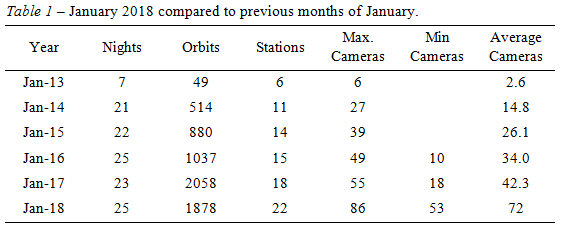A summary of the activity of the CAMS BeNeLux network during the month January 2018 is presented. This month was characterized by exceptional poor weather, lowest amount of sunshine since January 1935 during daylight, mostly overcast during the night. Thanks to the dedication of the network team still 11986 meteors were recorded, 4859 of which proved multiple station, or 41%. In total 1878 orbits were collected during this month.
1 Introduction
December 2017 was the worst December month in the short 6 years of CAMS BeNeLux history. When compared on a longer term this month had the lowest number of sunshine hours since December 1934. We all hoped to get somehow better weather for January 2018, but nature has no mercy, January 2018 became about as bad as December 2017. January 2018 had the lowest number of sunshine hours since 1935. The network got another month with long nights and rich meteor activity spoiled by bad weather.
2 January 2018 statistics
Motivation of volunteers depends a lot on an efficient system to collect the results, providing frequent feedback. The BeNeLux CAMS network is coordinated by Carl Johannink who provides all participants on a weekly basis with status updates, showing which CAMS stations reported their results. Whenever any unusual activity or any peculiar event occurred, a summary is shared with all participants. Data is being reported on a daily bases, but since the CAMS team works with volunteers who have other commitments as well, some people report their data only every few days. Once all data has been collected for a month, Carl Johannink sends a report to all participants with a final list of multiple station meteors and some statistics. This summary report is based on the data provided by Carl.
In spite of the unfavorable weather, CAMS BeNeLux managed to collect 11986 meteors with 93 operational cameras at 22 participating stations, with 4859 or 41% multistation meteors good for 1878 orbits. These results are not bad, on the contrary, taking into account the extraordinary bad weather it is a surprise that still such good result is obtained. This proves the remarkable efficiency of the CAMS BeNeLux system.
At best 86 of the 93 operational cameras were active during some nights in January 2018. On average 72.1 cameras were capturing per night. Only 6 nights did not yield any orbit, but even during these nights some meteors were registered. Thanks to AutoCAMS the surveillance of the BeNeLux sky was guaranteed with a minimum of 53 active cameras on all nights. On as many as 25 nights orbits have been collected. The long winter nights may often start with an overcast sky looking hopeless to get anything like clear sky, but nights of 13 to 14 hours may surprise with some unexpected clear sky. Casual observers often remain unaware of such clear periods, while the AutoCAMS observers get happily surprised when confirming unexpected meteors. A substantial part of the January 2018 orbits comes from this permanent alertness provided by AutoCAMS. Figure 1 shows the enormous increase in camera capacity, although that the number of orbits remained well below the number of 2017.

Figure 1 – Comparing January 2018 to previous months of January in the CAMS BeNeLux history. The blue bars represent the number of orbits, the red bars the maximum number of cameras running in a single night and the yellow bar the average number of cameras running per night.
Beyond the bad weather, many technical problems encountered by several CAMS participants definitely costed the network a number of orbits. The rapid expansion of the CAMS network, which got 50% more cameras during 2017, suffered some hardware and software issues. The number of camera faillures or CAMS PC drop-outs, failing synchronization of the PC clock, etc., accounts for a loss of at least 10% in number of orbits. The hardware and software challenges definitely require attention in the near future.

4 Conclusion
The team members spent a lot of efforts to get some results out of mostly cloudy nights. In spite of the bad weather still a very nice result has been obtained. Because of the exceptional bad weather the result is not in proportion to the amount of effort and equipment used, any normal weather January month may yield about the double of the 2018 scores. Technical issues with CAMS hardware need attention in the near future.
Acknowledgment
Many thanks to all participants in the CAMS BeNeLux network for their dedicated efforts. Thanks to Carl Johannink for providing all the data on which this report is based. The CAMS BeNeLux team is operated by the following volunteers:
Hans Betlem (Leiden, CAMS 371, 372 and 373), Felix Bettonvil (Utrecht, CAMS 376 and 377) , Jean-Marie Biets (Wilderen, CAMS 380, 381 and 382), Martin Breukers (Hengelo, CAMS 320, 321, 322, 323, 324, 325, 326 and 327), Bart Dessoy (Zoersel, CAMS 397, 398, 804, 805 and 806), Franky Dubois (Langemark, CAMS 386), Luc Gobin (Mechelen, CAMS 390, 391, 807 and 808), Robert Haas (Alphen aan de Rijn, CAMS 360, 361, 362, 363, 364, 365, 367 and 368), Robert Haas / Edwin van Dijk (Burlage, CAMS 801, 802, 821 and 822), Klaas Jobse (Oostkapelle, CAMS 330, 331, 332, 333, 334, 337, 338 and 339) , Carl Johannink (Gronau, CAMS 311, 312, 313, 314, 315, 316, 317 and 318), Hervé Lamy (Dourbes / Ukkel, CAMS 394 and 395/ 393), Koen Miskotte (Ermelo, CAMS 351, 352, 353 and 354), Piet Neels (Ooltgensplaat, CAMS 340, 341, 342, 343, 344 and 345, 349, 840), Tim Polfliet (Gent, CAMS 396), Steve Rau (Zillebeke, CAMS 385 and 387), Paul Roggemans (Mechelen, CAMS 383, 384, 388, 389, 399 and 809), Hans Schremmer (Niederkruechten, CAMS 803) and Erwin van Ballegoij (CAMS 347 and 348).




